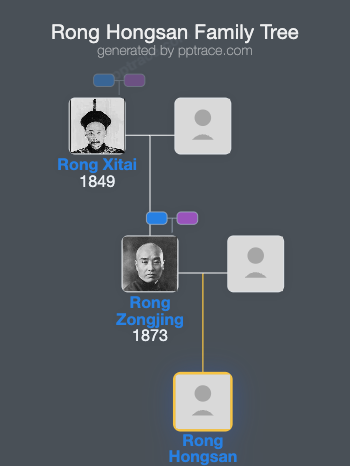
Rong Hongsan
| Name | Rong Hongsan |
| Title | Former Deputy General Manager of Shenxin Group |
| Gender | Male |
| Birthday | — |
| nationality | — |
| Source | https://baike.baidu.com/item/%E8%8D%A3%E9%B8%BF%E4%B8%89/23389474 |
| pptrace | View Family Tree |
| LastUpdate | 2025-07-11T09:16:18.896Z |
Introduction
Rong Hongsan, born in the early 20th century, with his exact birth date not publicly disclosed, received his education in the Hankou area during his early years and gradually entered the field of enterprise management. He was primarily associated with the Shenxin Group (Shensheng Textile Industrial Company) and served as vice general manager of Shenxin’s parent company, becoming one of the management members of the Rong family’s enterprise group.
In the early stages of his career, Rong Hongsan participated in the management of Hankou Fuxin Fifth Flour Mill and Shenxin Fourth Factory as Assistant General Manager and Chief Engineer. During the 1930s, he was successively promoted to manager of both factories, actively promoting technological reform and production capacity enhancement. As management positions changed in the 1930s, he gradually assumed more significant responsibilities, becoming a key figure in driving the company's development.
During the Anti-Japanese War, Rong Hongsan played a leadership role, overseeing the relocation of Shenxin Fourth Factory and Fuxin Fifth Factory. He led efforts to move these factories to places such as Baoji and Chongqing, ensuring the continuity of enterprise production. During the relocation, he also supervised the construction of subsidiary enterprises such as flour mills and Hongwen Paper Factory, forming a wartime rear industrial base and strengthening the company’s capacity for wartime production.
In terms of management system reform, Rong Hongsan implemented a workshop-specialized graduate management system, gradually abolishing the traditional foreman system. This reform was regarded as an important step towards the modernization of Rong’s corporate management practices and holds historical significance.
On the eve of 1949, as Shanghai was about to be liberated, Rong Hongsan, along with senior executives of Shenxin General Company including General Manager Rong Hongyuan, went to Hong Kong to participate in decisions regarding the transfer of enterprise assets to Hong Kong, Taiwan, and overseas. During this period, Shenxin Group’s assets—including gold, cotton yarn, fine cloth, and some manufacturing equipment—were transferred. This move aimed to secure the continued operation of the enterprise, protect its assets, and promote overseas development.
Overall, Rong Hongsan played a crucial role in enterprise management and development, especially in wartime relocation, institutional reform, and asset transfer. His career reflects the adjustments and transformations of Chinese industrial enterprises during turbulent times.
Family Tree
Tap to expand more relatives
